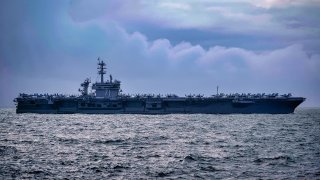'They Would Sink Quickly': The Navy's Aircraft Carrier Nightmare Is Just Unfixable
The article highlights the growing threat of anti-access/area-denial (A2/AD) systems developed by adversaries like China, Russia, Iran, and North Korea, which can overwhelm the US Navy's current missile defense capabilities.
What You Need to Know: The article highlights the growing threat of anti-access/area-denial (A2/AD) systems developed by adversaries like China, Russia, Iran, and North Korea, which can overwhelm the US Navy's current missile defense capabilities.
-These systems, particularly mass missile and hypersonic weapon attacks, pose significant risks to key assets like aircraft carriers. The author argues that the Navy must fundamentally rethink its force structure, shifting focus from traditional power projection to investing in long-range warfare technologies.
-Suggested strategies include expanding the use of offensive drones, enhancing the submarine fleet, and developing effective hypersonic weapons to counter or bypass A2/AD defenses, ensuring the US maintains its strategic advantage in contested environments.
Why the US Navy Must Rethink Its Strategy Against China's Missile Threat
The US Navy (indeed, Washington in general) seems to be averse to basic arithmetic.
Whether it be the massive deficit spending or even something as simple as protecting US warships from massive numbers of Chinese, Russian, Iranian, or North Korean missiles and hypersonic weapons associated with their increasingly complex arsenal of anti-access/area-denial (A2/AD) systems.
For example, US Navy warships have some of the world’s most sophisticated defense systems meant to protect the ship from incoming antiship missiles.
These systems are some of the most expensive and complex in the world. Yet, no amount of complexity can provide the kind of consistent and comprehensive shield that US warships require in the face of the growing A2/AD threat to their safety. This is especially true of US aircraft carriers which, if lost or seriously damaged, would quickly go from the Navy’s greatest power projection weapons platform to its greatest—most expensive—liability.
A Simple Equation Long Forgotten
Basically, it’s a simple math equation.
US warships can only defend themselves from a certain number of incoming missiles at once. American rivals, notably China, understand this fact. That’s why they’ve tailored their A2/AD systems to being able to overwhelm the Navy’s most sophisticated defensive systems.

While the Navy certainly has defenses against a certain number of incoming ballistic missiles, there are no known defensive countermeasures available to Navy warships that will protect against Chinese or Russian hypersonic weapons.
Staying with the mundane mathematics of missile defense, the Navy does not have limitless capabilities to defend their warships against attack once within range of A2/AD systems. What’s more, in 2013, the Washington Post revealed that the Pentagon had suffered a serious breach of its cybersecurity. Chinese cyber spies hacked into the Pentagon’s supposedly secure network and stole the classified designs for more than two dozen key US weapons systems.
Among those systems were the designs behind the Navy’s Aegis-class Destroyer’s ballistic missile defense system. This system is one of the most advanced ballistic missile defense systems in the world. Aircraft carriers operate a similar, though, different system known as the Ship Self-Defense System (SSDS). China’s hacking of the schematics for the Navy’s Aegis defense system not only means that China can build their own versions of this system. It also means that they can develop capabilities to overcome the systems employed on countless American warships. China has likely already tested their A2/AD systems against the data they stole from the Pentagon on the Navy’s shipborne missile defense systems and believe that they can overcome whatever defenses US warships employ.
If the enemy can overwhelm your missile defenses by simply throwing too many missiles in one barrage, then your ship is sunk. At the very least, in the case of aircraft carriers, the flight deck is badly damaged basically making the flat top a wasting asset on the battlefield. At that point, it’d become a race to both keep the ship from getting more damaged and taking it out of the battlespace before it was sunk.
Long-Range Warfare is the Future
The Navy has known for over a decade that China and its autocratic allies have had their number when it comes to stunting American power projection. Despite this fact, the Navy and the political class that oversees them have decided to continue operating as if the threat is nonexistent. Meanwhile, China and its autocratic allies have continued enhancing their ability to deny large portions of the world map to the US Navy when the inevitable great power war erupts.

What should have been—and must now—be done is for the Navy and the rest of Washington to fundamentally rethink its force structure. Looking at China’s threat to the US Navy in places like the South China Sea or the Taiwan Strait, the current paradigm will not yield victory for the US Navy. It will lead only to mass carnage, humiliation, and a bitter defeat at the hands of China’s advanced antiship and hypersonic missile forces.
If the Navy is one of the key components of America’s power projection into contested environments, and America’s enemies have developed effective ways of stunting that power projection, then the Navy and the rest of the military must invest in new technologies and capabilities that circumvent these A2/AD defenses.
Notably, the US should expand its commitment to building large swarms of offensive drones, it must enhance its submarine fleet, and it needs to develop effective hypersonic weapons systems of its own. Warfare among great powers will increasingly be fought at a distance. The Navy and other branches could develop these long-range strike capabilities that could knock out known A2/AD emplacements.
Once those are taken care of, then more conventional power projection methods can be resorted to.
Author Experience and Expertise: Brandon J. Weichert
Brandon J. Weichert, a National Interest national security analyst, is a former Congressional staffer and geopolitical analyst who is a contributor at The Washington Times, the Asia Times, and The-Pipeline. He is the author of Winning Space: How America Remains a Superpower, Biohacked: China’s Race to Control Life, and The Shadow War: Iran’s Quest for Supremacy. His next book, A Disaster of Our Own Making: How the West Lost Ukraine, is due October 22 from Encounter Books. Weichert can be followed via Twitter @WeTheBrandon.
All images are Creative Commons or Shutterstock.
From the Vault
Russia Freaked Out: Why the U.S. Navy 'Unretired' the Iowa-Class Battleships
Battleship vs. Battlecruiser: Iowa-Class vs. Russia's Kirov-Class (Who Wins?)


